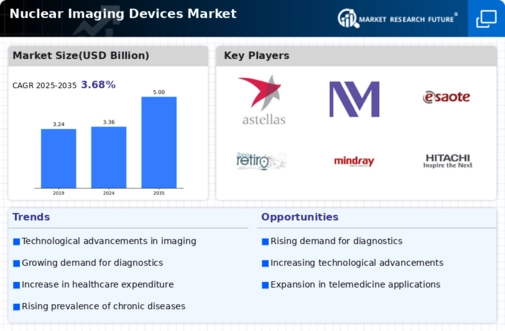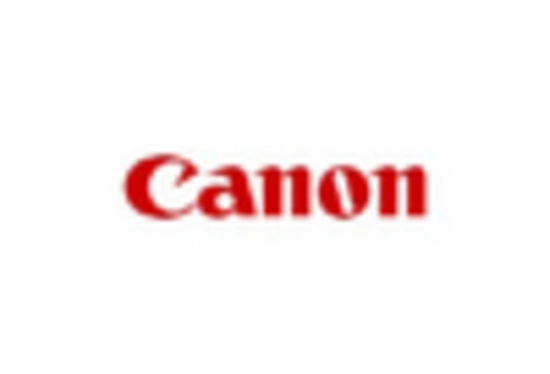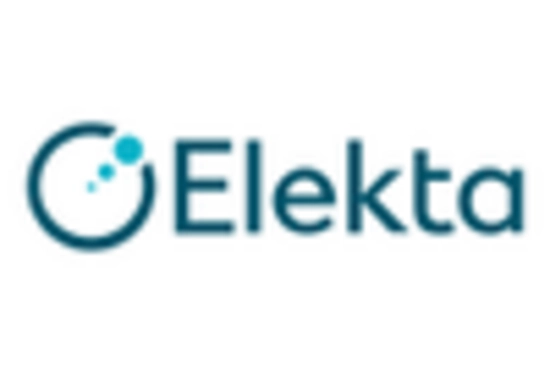Cardiology
Oncology
Neurology
Thyroid Function
Single Photon Emission Computed Tomography
Positron Emission Tomography
Hybrid Imaging Systems
Hospitals
Diagnostic Centers
Research Institutions
Cobalt-60
Technetium-99m
Gallium-68
North America
Europe
South America
Asia Pacific
Middle East and Africa
North America Outlook (USD Billion, 2019-2035)
North America Nuclear Imaging Devices Market by Application Type
Cardiology
Oncology
Neurology
Thyroid Function
North America Nuclear Imaging Devices Market by Product Type
Single Photon Emission Computed Tomography
Positron Emission Tomography
Hybrid Imaging Systems
North America Nuclear Imaging Devices Market by End Use Type
Hospitals
Diagnostic Centers
Research Institutions
North America Nuclear Imaging Devices Market by Technology Type
Cobalt-60
Technetium-99m
Gallium-68
North America Nuclear Imaging Devices Market by Regional Type
US
Canada
US Outlook (USD Billion, 2019-2035)
US Nuclear Imaging Devices Market by Application Type
Cardiology
Oncology
Neurology
Thyroid Function
US Nuclear Imaging Devices Market by Product Type
Single Photon Emission Computed Tomography
Positron Emission Tomography
Hybrid Imaging Systems
US Nuclear Imaging Devices Market by End Use Type
Hospitals
Diagnostic Centers
Research Institutions
US Nuclear Imaging Devices Market by Technology Type
Cobalt-60
Technetium-99m
Gallium-68
CANADA Outlook (USD Billion, 2019-2035)
CANADA Nuclear Imaging Devices Market by Application Type
Cardiology
Oncology
Neurology
Thyroid Function
CANADA Nuclear Imaging Devices Market by Product Type
Single Photon Emission Computed Tomography
Positron Emission Tomography
Hybrid Imaging Systems
CANADA Nuclear Imaging Devices Market by End Use Type
Hospitals
Diagnostic Centers
Research Institutions
CANADA Nuclear Imaging Devices Market by Technology Type
Cobalt-60
Technetium-99m
Gallium-68
Europe Outlook (USD Billion, 2019-2035)
Europe Nuclear Imaging Devices Market by Application Type
Cardiology
Oncology
Neurology
Thyroid Function
Europe Nuclear Imaging Devices Market by Product Type
Single Photon Emission Computed Tomography
Positron Emission Tomography
Hybrid Imaging Systems
Europe Nuclear Imaging Devices Market by End Use Type
Hospitals
Diagnostic Centers
Research Institutions
Europe Nuclear Imaging Devices Market by Technology Type
Cobalt-60
Technetium-99m
Gallium-68
Europe Nuclear Imaging Devices Market by Regional Type
Germany
UK
France
Russia
Italy
Spain
Rest of Europe
GERMANY Outlook (USD Billion, 2019-2035)
GERMANY Nuclear Imaging Devices Market by Application Type
Cardiology
Oncology
Neurology
Thyroid Function
GERMANY Nuclear Imaging Devices Market by Product Type
Single Photon Emission Computed Tomography
Positron Emission Tomography
Hybrid Imaging Systems
GERMANY Nuclear Imaging Devices Market by End Use Type
Hospitals
Diagnostic Centers
Research Institutions
GERMANY Nuclear Imaging Devices Market by Technology Type
Cobalt-60
Technetium-99m
Gallium-68
UK Outlook (USD Billion, 2019-2035)
UK Nuclear Imaging Devices Market by Application Type
Cardiology
Oncology
Neurology
Thyroid Function
UK Nuclear Imaging Devices Market by Product Type
Single Photon Emission Computed Tomography
Positron Emission Tomography
Hybrid Imaging Systems
UK Nuclear Imaging Devices Market by End Use Type
Hospitals
Diagnostic Centers
Research Institutions
UK Nuclear Imaging Devices Market by Technology Type
Cobalt-60
Technetium-99m
Gallium-68
FRANCE Outlook (USD Billion, 2019-2035)
FRANCE Nuclear Imaging Devices Market by Application Type
Cardiology
Oncology
Neurology
Thyroid Function
FRANCE Nuclear Imaging Devices Market by Product Type
Single Photon Emission Computed Tomography
Positron Emission Tomography
Hybrid Imaging Systems
FRANCE Nuclear Imaging Devices Market by End Use Type
Hospitals
Diagnostic Centers
Research Institutions
FRANCE Nuclear Imaging Devices Market by Technology Type
Cobalt-60
Technetium-99m
Gallium-68
RUSSIA Outlook (USD Billion, 2019-2035)
RUSSIA Nuclear Imaging Devices Market by Application Type
Cardiology
Oncology
Neurology
Thyroid Function
RUSSIA Nuclear Imaging Devices Market by Product Type
Single Photon Emission Computed Tomography
Positron Emission Tomography
Hybrid Imaging Systems
RUSSIA Nuclear Imaging Devices Market by End Use Type
Hospitals
Diagnostic Centers
Research Institutions
RUSSIA Nuclear Imaging Devices Market by Technology Type
Cobalt-60
Technetium-99m
Gallium-68
ITALY Outlook (USD Billion, 2019-2035)
ITALY Nuclear Imaging Devices Market by Application Type
Cardiology
Oncology
Neurology
Thyroid Function
ITALY Nuclear Imaging Devices Market by Product Type
Single Photon Emission Computed Tomography
Positron Emission Tomography
Hybrid Imaging Systems
ITALY Nuclear Imaging Devices Market by End Use Type
Hospitals
Diagnostic Centers
Research Institutions
ITALY Nuclear Imaging Devices Market by Technology Type
Cobalt-60
Technetium-99m
Gallium-68
SPAIN Outlook (USD Billion, 2019-2035)
SPAIN Nuclear Imaging Devices Market by Application Type
Cardiology
Oncology
Neurology
Thyroid Function
SPAIN Nuclear Imaging Devices Market by Product Type
Single Photon Emission Computed Tomography
Positron Emission Tomography
Hybrid Imaging Systems
SPAIN Nuclear Imaging Devices Market by End Use Type
Hospitals
Diagnostic Centers
Research Institutions
SPAIN Nuclear Imaging Devices Market by Technology Type
Cobalt-60
Technetium-99m
Gallium-68
REST OF EUROPE Outlook (USD Billion, 2019-2035)
REST OF EUROPE Nuclear Imaging Devices Market by Application Type
Cardiology
Oncology
Neurology
Thyroid Function
REST OF EUROPE Nuclear Imaging Devices Market by Product Type
Single Photon Emission Computed Tomography
Positron Emission Tomography
Hybrid Imaging Systems
REST OF EUROPE Nuclear Imaging Devices Market by End Use Type
Hospitals
Diagnostic Centers
Research Institutions
REST OF EUROPE Nuclear Imaging Devices Market by Technology Type
Cobalt-60
Technetium-99m
Gallium-68
APAC Outlook (USD Billion, 2019-2035)
APAC Nuclear Imaging Devices Market by Application Type
Cardiology
Oncology
Neurology
Thyroid Function
APAC Nuclear Imaging Devices Market by Product Type
Single Photon Emission Computed Tomography
Positron Emission Tomography
Hybrid Imaging Systems
APAC Nuclear Imaging Devices Market by End Use Type
Hospitals
Diagnostic Centers
Research Institutions
APAC Nuclear Imaging Devices Market by Technology Type
Cobalt-60
Technetium-99m
Gallium-68
APAC Nuclear Imaging Devices Market by Regional Type
China
India
Japan
South Korea
Malaysia
Thailand
Indonesia
Rest of APAC
CHINA Outlook (USD Billion, 2019-2035)
CHINA Nuclear Imaging Devices Market by Application Type
Cardiology
Oncology
Neurology
Thyroid Function
CHINA Nuclear Imaging Devices Market by Product Type
Single Photon Emission Computed Tomography
Positron Emission Tomography
Hybrid Imaging Systems
CHINA Nuclear Imaging Devices Market by End Use Type
Hospitals
Diagnostic Centers
Research Institutions
CHINA Nuclear Imaging Devices Market by Technology Type
Cobalt-60
Technetium-99m
Gallium-68
INDIA Outlook (USD Billion, 2019-2035)
INDIA Nuclear Imaging Devices Market by Application Type
Cardiology
Oncology
Neurology
Thyroid Function
INDIA Nuclear Imaging Devices Market by Product Type
Single Photon Emission Computed Tomography
Positron Emission Tomography
Hybrid Imaging Systems
INDIA Nuclear Imaging Devices Market by End Use Type
Hospitals
Diagnostic Centers
Research Institutions
INDIA Nuclear Imaging Devices Market by Technology Type
Cobalt-60
Technetium-99m
Gallium-68
JAPAN Outlook (USD Billion, 2019-2035)
JAPAN Nuclear Imaging Devices Market by Application Type
Cardiology
Oncology
Neurology
Thyroid Function
JAPAN Nuclear Imaging Devices Market by Product Type
Single Photon Emission Computed Tomography
Positron Emission Tomography
Hybrid Imaging Systems
JAPAN Nuclear Imaging Devices Market by End Use Type
Hospitals
Diagnostic Centers
Research Institutions
JAPAN Nuclear Imaging Devices Market by Technology Type
Cobalt-60
Technetium-99m
Gallium-68
SOUTH KOREA Outlook (USD Billion, 2019-2035)
SOUTH KOREA Nuclear Imaging Devices Market by Application Type
Cardiology
Oncology
Neurology
Thyroid Function
SOUTH KOREA Nuclear Imaging Devices Market by Product Type
Single Photon Emission Computed Tomography
Positron Emission Tomography
Hybrid Imaging Systems
SOUTH KOREA Nuclear Imaging Devices Market by End Use Type
Hospitals
Diagnostic Centers
Research Institutions
SOUTH KOREA Nuclear Imaging Devices Market by Technology Type
Cobalt-60
Technetium-99m
Gallium-68
MALAYSIA Outlook (USD Billion, 2019-2035)
MALAYSIA Nuclear Imaging Devices Market by Application Type
Cardiology
Oncology
Neurology
Thyroid Function
MALAYSIA Nuclear Imaging Devices Market by Product Type
Single Photon Emission Computed Tomography
Positron Emission Tomography
Hybrid Imaging Systems
MALAYSIA Nuclear Imaging Devices Market by End Use Type
Hospitals
Diagnostic Centers
Research Institutions
MALAYSIA Nuclear Imaging Devices Market by Technology Type
Cobalt-60
Technetium-99m
Gallium-68
THAILAND Outlook (USD Billion, 2019-2035)
THAILAND Nuclear Imaging Devices Market by Application Type
Cardiology
Oncology
Neurology
Thyroid Function
THAILAND Nuclear Imaging Devices Market by Product Type
Single Photon Emission Computed Tomography
Positron Emission Tomography
Hybrid Imaging Systems
THAILAND Nuclear Imaging Devices Market by End Use Type
Hospitals
Diagnostic Centers
Research Institutions
THAILAND Nuclear Imaging Devices Market by Technology Type
Cobalt-60
Technetium-99m
Gallium-68
INDONESIA Outlook (USD Billion, 2019-2035)
INDONESIA Nuclear Imaging Devices Market by Application Type
Cardiology
Oncology
Neurology
Thyroid Function
INDONESIA Nuclear Imaging Devices Market by Product Type
Single Photon Emission Computed Tomography
Positron Emission Tomography
Hybrid Imaging Systems
INDONESIA Nuclear Imaging Devices Market by End Use Type
Hospitals
Diagnostic Centers
Research Institutions
INDONESIA Nuclear Imaging Devices Market by Technology Type
Cobalt-60
Technetium-99m
Gallium-68
REST OF APAC Outlook (USD Billion, 2019-2035)
REST OF APAC Nuclear Imaging Devices Market by Application Type
Cardiology
Oncology
Neurology
Thyroid Function
REST OF APAC Nuclear Imaging Devices Market by Product Type
Single Photon Emission Computed Tomography
Positron Emission Tomography
Hybrid Imaging Systems
REST OF APAC Nuclear Imaging Devices Market by End Use Type
Hospitals
Diagnostic Centers
Research Institutions
REST OF APAC Nuclear Imaging Devices Market by Technology Type
Cobalt-60
Technetium-99m
Gallium-68
South America Outlook (USD Billion, 2019-2035)
South America Nuclear Imaging Devices Market by Application Type
Cardiology
Oncology
Neurology
Thyroid Function
South America Nuclear Imaging Devices Market by Product Type
Single Photon Emission Computed Tomography
Positron Emission Tomography
Hybrid Imaging Systems
South America Nuclear Imaging Devices Market by End Use Type
Hospitals
Diagnostic Centers
Research Institutions
South America Nuclear Imaging Devices Market by Technology Type
Cobalt-60
Technetium-99m
Gallium-68
South America Nuclear Imaging Devices Market by Regional Type
Brazil
Mexico
Argentina
Rest of South America
BRAZIL Outlook (USD Billion, 2019-2035)
BRAZIL Nuclear Imaging Devices Market by Application Type
Cardiology
Oncology
Neurology
Thyroid Function
BRAZIL Nuclear Imaging Devices Market by Product Type
Single Photon Emission Computed Tomography
Positron Emission Tomography
Hybrid Imaging Systems
BRAZIL Nuclear Imaging Devices Market by End Use Type
Hospitals
Diagnostic Centers
Research Institutions
BRAZIL Nuclear Imaging Devices Market by Technology Type
Cobalt-60
Technetium-99m
Gallium-68
MEXICO Outlook (USD Billion, 2019-2035)
MEXICO Nuclear Imaging Devices Market by Application Type
Cardiology
Oncology
Neurology
Thyroid Function
MEXICO Nuclear Imaging Devices Market by Product Type
Single Photon Emission Computed Tomography
Positron Emission Tomography
Hybrid Imaging Systems
MEXICO Nuclear Imaging Devices Market by End Use Type
Hospitals
Diagnostic Centers
Research Institutions
MEXICO Nuclear Imaging Devices Market by Technology Type
Cobalt-60
Technetium-99m
Gallium-68
ARGENTINA Outlook (USD Billion, 2019-2035)
ARGENTINA Nuclear Imaging Devices Market by Application Type
Cardiology
Oncology
Neurology
Thyroid Function
ARGENTINA Nuclear Imaging Devices Market by Product Type
Single Photon Emission Computed Tomography
Positron Emission Tomography
Hybrid Imaging Systems
ARGENTINA Nuclear Imaging Devices Market by End Use Type
Hospitals
Diagnostic Centers
Research Institutions
ARGENTINA Nuclear Imaging Devices Market by Technology Type
Cobalt-60
Technetium-99m
Gallium-68
REST OF SOUTH AMERICA Outlook (USD Billion, 2019-2035)
REST OF SOUTH AMERICA Nuclear Imaging Devices Market by Application Type
Cardiology
Oncology
Neurology
Thyroid Function
REST OF SOUTH AMERICA Nuclear Imaging Devices Market by Product Type
Single Photon Emission Computed Tomography
Positron Emission Tomography
Hybrid Imaging Systems
REST OF SOUTH AMERICA Nuclear Imaging Devices Market by End Use Type
Hospitals
Diagnostic Centers
Research Institutions
REST OF SOUTH AMERICA Nuclear Imaging Devices Market by Technology Type
Cobalt-60
Technetium-99m
Gallium-68
MEA Outlook (USD Billion, 2019-2035)
MEA Nuclear Imaging Devices Market by Application Type
Cardiology
Oncology
Neurology
Thyroid Function
MEA Nuclear Imaging Devices Market by Product Type
Single Photon Emission Computed Tomography
Positron Emission Tomography
Hybrid Imaging Systems
MEA Nuclear Imaging Devices Market by End Use Type
Hospitals
Diagnostic Centers
Research Institutions
MEA Nuclear Imaging Devices Market by Technology Type
Cobalt-60
Technetium-99m
Gallium-68
MEA Nuclear Imaging Devices Market by Regional Type
GCC Countries
South Africa
Rest of MEA
GCC COUNTRIES Outlook (USD Billion, 2019-2035)
GCC COUNTRIES Nuclear Imaging Devices Market by Application Type
Cardiology
Oncology
Neurology
Thyroid Function
GCC COUNTRIES Nuclear Imaging Devices Market by Product Type
Single Photon Emission Computed Tomography
Positron Emission Tomography
Hybrid Imaging Systems
GCC COUNTRIES Nuclear Imaging Devices Market by End Use Type
Hospitals
Diagnostic Centers
Research Institutions
GCC COUNTRIES Nuclear Imaging Devices Market by Technology Type
Cobalt-60
Technetium-99m
Gallium-68
SOUTH AFRICA Outlook (USD Billion, 2019-2035)
SOUTH AFRICA Nuclear Imaging Devices Market by Application Type
Cardiology
Oncology
Neurology
Thyroid Function
SOUTH AFRICA Nuclear Imaging Devices Market by Product Type
Single Photon Emission Computed Tomography
Positron Emission Tomography
Hybrid Imaging Systems
SOUTH AFRICA Nuclear Imaging Devices Market by End Use Type
Hospitals
Diagnostic Centers
Research Institutions
SOUTH AFRICA Nuclear Imaging Devices Market by Technology Type
Cobalt-60
Technetium-99m
Gallium-68
REST OF MEA Outlook (USD Billion, 2019-2035)
REST OF MEA Nuclear Imaging Devices Market by Application Type
Cardiology
Oncology
Neurology
Thyroid Function
REST OF MEA Nuclear Imaging Devices Market by Product Type
Single Photon Emission Computed Tomography
Positron Emission Tomography
Hybrid Imaging Systems
REST OF MEA Nuclear Imaging Devices Market by End Use Type
Hospitals
Diagnostic Centers
Research Institutions
REST OF MEA Nuclear Imaging Devices Market by Technology Type
Cobalt-60
Technetium-99m
Gallium-68









Leave a Comment